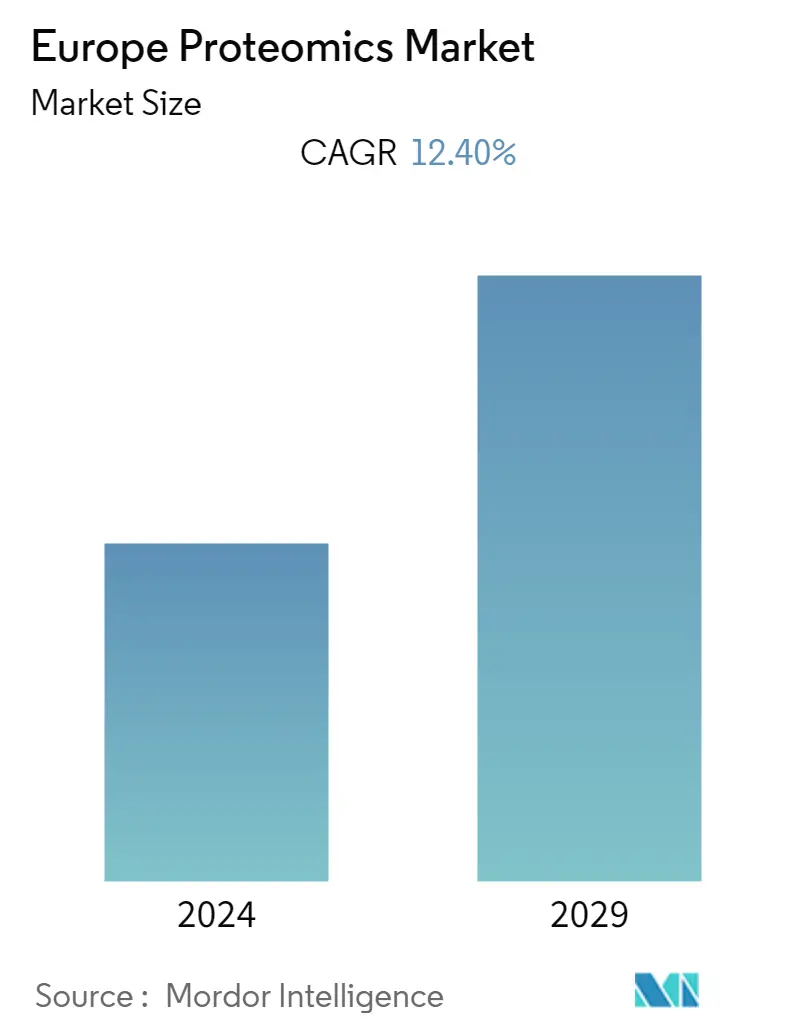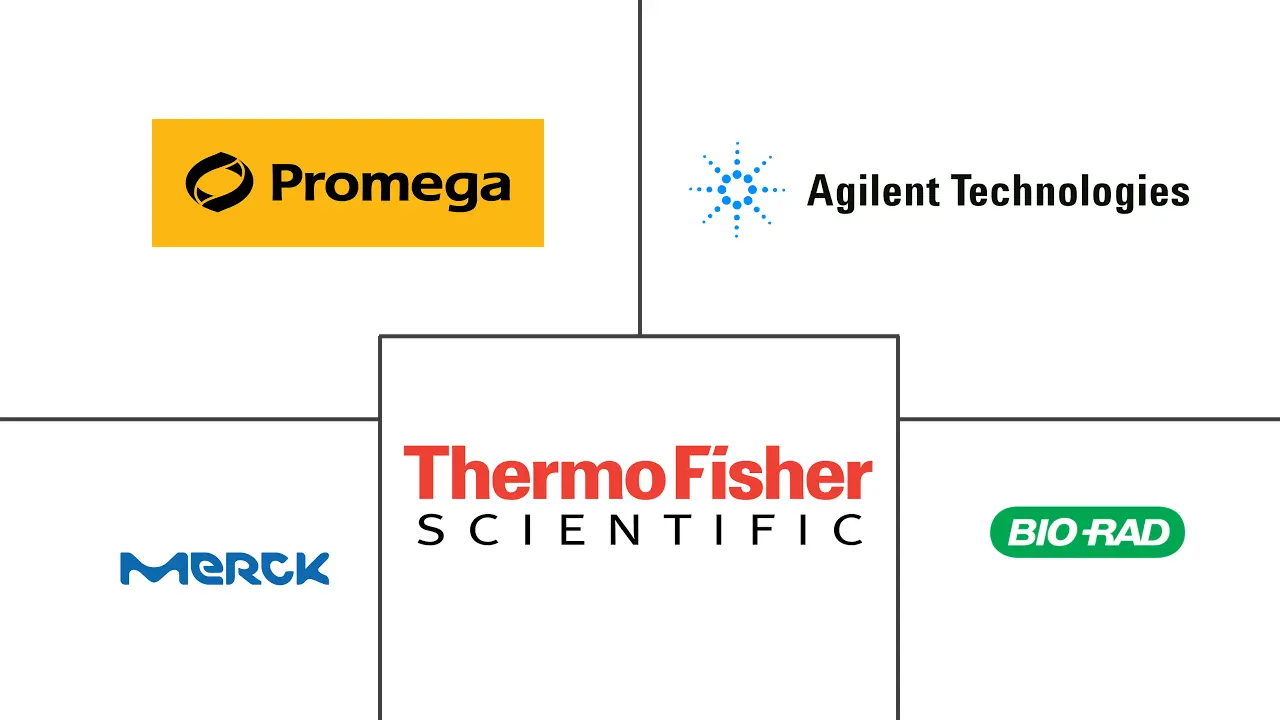Market Size of Europe Proteomics Industry

| Study Period | 2019 - 2029 |
| Base Year For Estimation | 2023 |
| Forecast Data Period | 2024 - 2029 |
| Historical Data Period | 2019 - 2022 |
| CAGR | 12.40 % |
Major Players
*Disclaimer: Major Players sorted in no particular order |
Europe Proteomics Market Analysis
In the base year, the Europe proteomics market was worth USD 5,356 million. By the end of the forecast period, it is expected to record a CAGR of 12.4% which is worth USD 10,793 million.
The COVID-19 pandemic turned the spotlight on proteomic studies, and thus, it is expected to drive the studied market growth during the present crisis. According to an article published in the International Journal of Molecular Sciences in March 2022, it has been observed that omics-based technologies were largely adopted during the COVID-19 pandemic. The omic technology could be applied at every level of application, from the detection of mutations, methods of diagnosis or monitoring, drug target discovery, and vaccine generation, to the basic definition of the pathophysiological processes and the biochemical mechanisms behind the infection and spread of SARS-CoV-2. Proteomics aids in the identification of novel biomarkers of the SARS-CoV-2 virus and thus provides effective opportunities for point-of-care clinical healthcare delivery in the most cost-effective manner. Thus, the wide application of proteomics in developing therapeutics for coronavirus has impacted market growth during a pandemic. Moreover, the rising adoption of proteomics technology by pharmaceutical companies and the increasing demand for personalized medicines also increased market growth and are expected to continue over the forecast period.
Factors such as the rising demand for personalized medicine, increasing research and expenditure, and government funding for proteomics, as well as technological advancements, are boosting the market's growth.
Proteomics has received great attention over the last decade, particularly in the fields of diagnosis, drug research, and drug development. It has various applications, ranging from the identification of proteins to the purification and separation of the proteins to study their nature and properties. It has numerous applications in identifying protein-related disorders or diseases in the body.Thus, it is evolving into an important tool in the field of life sciences.
Furthermore, increasing demand for personalized medicine in Europe, along with the presence of key market players such as Merck KGaA, is expected to boost regional growth. Also, positive support from the local authorities in Europe and initiatives by research organizations to advance proteomics technologies such as chemoproteomics and spectrometry are expected to further fuel market growth. For example, Biognosys, a Swiss company, will launch Spectronaut 16 and present major scientific and technological advances of its proprietary proteomics research services at the American Society for Mass Spectrometry (ASMS) Annual Conference in May 2022.
Similarly, in February 2021, the international metaproteomics community launched the Metaproteomics Initiative to promote the dissemination of metaproteomics fundamentals, advancements, and applications through collaborative networking in microbiome research.
Therefore, owing to the aforementioned factors, the studied market is expected to grow over the forecast period. The high cost of instruments, on the other hand, is likely to slow the growth of the proteomics market in Europe over the next few years.
Europe Proteomics Industry Segmentation
As per the scope of the report, proteomics is the study of protein structure and function. At the cellular level, proteomics deals with topics, such as which proteins are expressed, when and where they are expressed, what their structures are in both active and inactive states, what roles they play in the life of the cell, and how they interact with other proteins and molecules. The Europe proteomics market is divided into three sections: products and services (instrumentation technology (spectroscopy, chromatography, electrophoresis, protein microarrays, X-ray crystallography, and other instrumentation technologies), reagents, and software and services), application (clinical diagnostics, drug discovery, and other applications), and geography (Germany, United Kingdom, France, Italy, Spain, and the Rest of Europe). The report offers the value (in USD million) for the above segments.
| By Products and Services | ||||||||
| ||||||||
| Reagents | ||||||||
| Software and Services |
| By Application | |
| Clinical Diagnostics | |
| Drug Discovery | |
| Other Applications |
| Geography | |
| Germany | |
| United Kingdom | |
| France | |
| Italy | |
| Spain | |
| Rest of Europe |
Europe Proteomics Market Size Summary
The European proteomics market is poised for significant growth, driven by the increasing demand for personalized medicine and advancements in omics-based technologies. The COVID-19 pandemic has accelerated the adoption of proteomics, highlighting its critical role in drug discovery, vaccine development, and understanding disease mechanisms. This has led to a surge in interest and investment from pharmaceutical companies and research organizations, further propelling market expansion. The market is characterized by the presence of key players such as Merck KGaA and Thermo Fisher Scientific, who are actively involved in developing advanced proteomics technologies and instruments. These developments are expected to enhance the capabilities of proteomics in diagnosing and treating chronic diseases, thereby boosting market growth over the forecast period.
The market's growth is also supported by government funding and increasing research expenditure, which are fostering innovation and technological advancements in proteomics. The United Kingdom, in particular, is expected to witness substantial market growth due to its high prevalence of chronic diseases and robust healthcare spending. The introduction of new proteomics services and collaborations among companies are further contributing to the market's expansion. Despite the high cost of proteomics instruments posing a challenge, the overall outlook for the European proteomics market remains positive, with continued growth anticipated as the demand for effective and personalized healthcare solutions rises.
Europe Proteomics Market Size - Table of Contents
-
1. MARKET DYNAMICS
-
1.1 Market Overview
-
1.2 Market Drivers
-
1.2.1 Rising Demand for Personalized Medicine
-
1.2.2 Increasing R&D Expenditure and Government Funding for Proteomics
-
1.2.3 Technological Advancements
-
-
1.3 Market Restraints
-
1.3.1 High Cost of Instruments
-
-
1.4 Porter's Five Forces Analysis
-
1.4.1 Threat of New Entrants
-
1.4.2 Bargaining Power of Buyers/Consumers
-
1.4.3 Bargaining Power of Suppliers
-
1.4.4 Threat of Substitute Products
-
1.4.5 Intensity of Competitive Rivalry
-
-
-
2. MARKET SEGMENTATION (Market Size by Value - USD million)
-
2.1 By Products and Services
-
2.1.1 Instrumentation Technology
-
2.1.1.1 Spectroscopy
-
2.1.1.2 Chromatography
-
2.1.1.3 Electrophoresis
-
2.1.1.4 Protein Microarrays
-
2.1.1.5 X-ray Crystallography
-
2.1.1.6 Other Instrumentation Technologies
-
-
2.1.2 Reagents
-
2.1.3 Software and Services
-
-
2.2 By Application
-
2.2.1 Clinical Diagnostics
-
2.2.2 Drug Discovery
-
2.2.3 Other Applications
-
-
2.3 Geography
-
2.3.1 Germany
-
2.3.2 United Kingdom
-
2.3.3 France
-
2.3.4 Italy
-
2.3.5 Spain
-
2.3.6 Rest of Europe
-
-
Europe Proteomics Market Size FAQs
What is the current Europe Proteomics Market size?
The Europe Proteomics Market is projected to register a CAGR of 12.40% during the forecast period (2024-2029)
Who are the key players in Europe Proteomics Market?
Agilent Technologies, Inc., Bio-Rad Laboratories, Inc., Thermo Fisher Scientific, Inc., Merck KGaA and Promega Corporation are the major companies operating in the Europe Proteomics Market.

